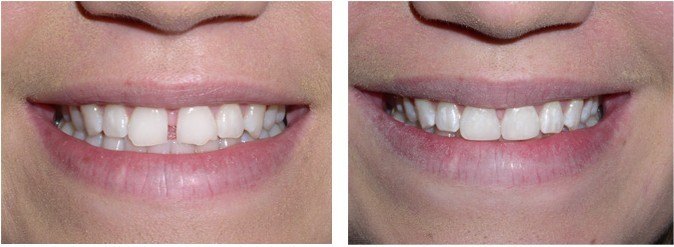
Dental bonding for gaps is a cosmetic dentistry procedure that effectively closes gaps between teeth. It entails applying a tooth-colored resin material to the tooth’s surface, skillfully shaping it, and polishing it to seamlessly blend with your natural teeth. This versatile technique addresses various dental concerns, including the elimination of gaps. By meticulously applying the bonding material and using a special light to harden it, dentists can create a strong, natural-looking bond, providing a quick and affordable solution for small gap closure and enhancing your smile’s aesthetics. Dental bonding for gaps is indeed a popular choice, offering a flawless smile transformation.
Dental Bonding for Gaps in the Teeth
Dental bonding is a popular cosmetic dental procedure that can be used to fix gaps between teeth. Many people are self-conscious about having gaps in their smile, and dental bonding offers a simple and effective solution. This article will explore how dental bonding works and its effectiveness in fixing gaps.
What is Dental Bonding?
Dental bonding is a procedure where a tooth-colored resin material is applied and bonded to the teeth using a special light. It is a relatively quick and painless procedure that can be completed in a single dental visit. The resin material used in dental bonding is durable and can be matched to the color of your natural teeth, making it virtually indistinguishable.
Dental bonding is commonly used to fix a variety of dental issues, including gaps between teeth, chipped or cracked teeth, stained or discolored teeth, and even to change the shape or size of teeth. It is a versatile treatment option that can greatly improve the appearance of your smile.
The Process of Dental Bonding
The process of dental bonding typically involves the following steps:
1. Preparation: The dentist will start by preparing the tooth or teeth by roughening the surface and applying a conditioning liquid. This helps the bonding material adhere properly to the tooth.
2. Application of the Bonding Material: The dentist will apply the tooth-colored resin to the prepared tooth and mold it into the desired shape. The resin is soft and pliable, allowing the dentist to sculpt it to fill in the gap between teeth.
3. Bonding: Once the resin is in place, the dentist will use a special light to cure and harden the material. This step ensures that the bonding material becomes strong and durable.
4. Shaping and Polishing: After the bonding material has hardened, the dentist will shape and polish it to match the natural contours of your teeth. This will give your smile a seamless and natural appearance.
The Benefits of Dental Bonding for Fixing Gaps
There are several benefits to using dental bonding to fix gaps between teeth:
1. Quick and Painless: Dental bonding is a relatively quick and painless procedure. Unlike other dental treatments, such as dental implants or braces, bonding can be completed in a single dental visit.
2. Cost-Effective: Dental bonding is a cost-effective option compared to other cosmetic dental procedures. It offers a more affordable solution for fixing gaps between teeth.
3. Natural Appearance: The resin material used in dental bonding can be color-matched to your natural teeth, ensuring a seamless and natural appearance. The bonding material is also stain-resistant, so your smile will remain bright and beautiful.
4. Non-Invasive: Dental bonding is a non-invasive procedure that does not require any removal of tooth structure. It is a conservative approach to improving the appearance of your smile.
5. Versatile: Dental bonding can be used to fix not only gaps between teeth but also a variety of other dental issues. It is a versatile treatment option that can address multiple cosmetic concerns.
In conclusion, dental bonding is an effective solution for fixing gaps between teeth. It is a quick, painless, and cost-effective procedure that offers a natural-looking result. With its versatility and non-invasive nature, dental bonding is a popular choice for those looking to enhance their smile. Consult with your dentist to determine if dental bonding is the right option for you.
Key Takeaways: Dental Bonding for Gaps in the Teeth
- Dental bonding is a procedure that can be used to fix small gaps between teeth.
- It involves applying a tooth-colored resin to the teeth and shaping it to close the gaps.
- Dental bonding is a quick and affordable option for fixing minor gaps.
- However, it may not be suitable for larger gaps or more severe dental issues.
- Consult with a dentist to determine if dental bonding is the right solution for your specific case.
Frequently Asked Questions
What is dental bonding?
Dental bonding is a cosmetic dental procedure in which a tooth-colored resin material is applied to the teeth and bonded using a special light. It is commonly used to repair chips, cracks, and gaps in teeth, as well as to improve the appearance of discolored or misshapen teeth.
The bonding material is carefully sculpted and shaped to match the natural teeth, resulting in a seamless and natural-looking smile. Dental bonding is a non-invasive and relatively quick procedure, making it a popular choice for those looking to enhance their smile.
How does dental bonding fix gaps?
Preparing the Teeth
- The process begins with tooth preparation to create an ideal bonding surface.
- The dentist etches the tooth surfaces, creating a rough texture that facilitates the bonding material’s adherence.
Application of Tooth-Colored Resin
- After preparation, the dentist applies tooth-colored resin to the teeth.
- The resin is carefully shaped to fill in the gaps and achieve the desired look.
Hardening the Resin
- A special light is used to harden the resin, ensuring it bonds securely to the teeth.
- This step solidifies the bonding material and sets it in place.
Shaping and Polishing
- Once the resin is set, the dentist further shapes and polishes it.
- This final step ensures that the bonding material blends seamlessly with the natural teeth, creating a flawless appearance.
Is dental bonding a permanent solution for gaps?
Dental bonding is a long-lasting solution for fixing gaps between teeth, but it is not considered permanent. On average, dental bonding can last between 5 to 10 years with proper care. However, the lifespan of dental bonding can vary depending on factors such as oral hygiene habits, diet, and lifestyle choices.
If the bonding material becomes damaged or discolored over time, it can be repaired or replaced by a dentist. Regular dental check-ups and good oral hygiene practices can help prolong the lifespan of dental bonding and maintain a beautiful smile.
Are there any limitations to dental bonding for fixing gaps?
While dental bonding is a versatile and effective treatment for fixing gaps between teeth, it may not be suitable for all cases. The size and location of the gaps, as well as the overall condition of the teeth, will determine whether dental bonding is the most appropriate solution.
In some cases, orthodontic treatment or other cosmetic procedures such as veneers may be recommended to achieve the desired results. It is best to consult with a qualified dentist who can evaluate your specific case and recommend the most suitable treatment option for fixing gaps between your teeth.
How much does dental bonding for fixing gaps cost?
The cost of dental bonding for fixing gaps between teeth can vary depending on factors such as the number of teeth being treated, the complexity of the case, and the location of the dental practice. On average, the cost of dental bonding can range from $300 to $600 per tooth.
It is important to note that dental bonding is considered a cosmetic procedure and may not be covered by dental insurance. However, some dental practices offer financing options or payment plans to make treatment more affordable. It is recommended to discuss the cost and payment options with your dentist during the consultation.
Can you close gaps with dental bonding?
Final Summary: Can Dental Bonding Fix Gaps?
Dental bonding for gaps is an effective cosmetic dental procedure. It involves applying a tooth-colored resin material to the tooth surface and shaping it to fill the gap. The resin is then hardened with a special light, creating a strong and natural-looking bond. Dental bonding not only closes gaps but also enhances tooth shape and color. By using tooth-colored resin, it seamlessly blends with natural teeth, offering a non-invasive way to improve your smile. This cost-effective option provides immediate results, making it a fantastic solution for those seeking to fix gaps between their teeth. Consult your dentist and say goodbye to those gaps for a confident, radiant smile!
Call or Book appointment online
:Ace Dental Care Alpharetta office: 678-562-1555 - Book Now
Ace Dental Care Norcross office: 770-806-1255 - Book Now
Disclaimer
This blog post was generated by artificial intelligence. The content of this post may not be accurate or complete, and should not be relied upon as a substitute for professional advice. If you have any questions about the content of this post, please contact us.
We are constantly working to improve the accuracy and quality of our AI-generated content. However, there may still be errors or inaccuracies. We apologize for any inconvenience this may cause.





